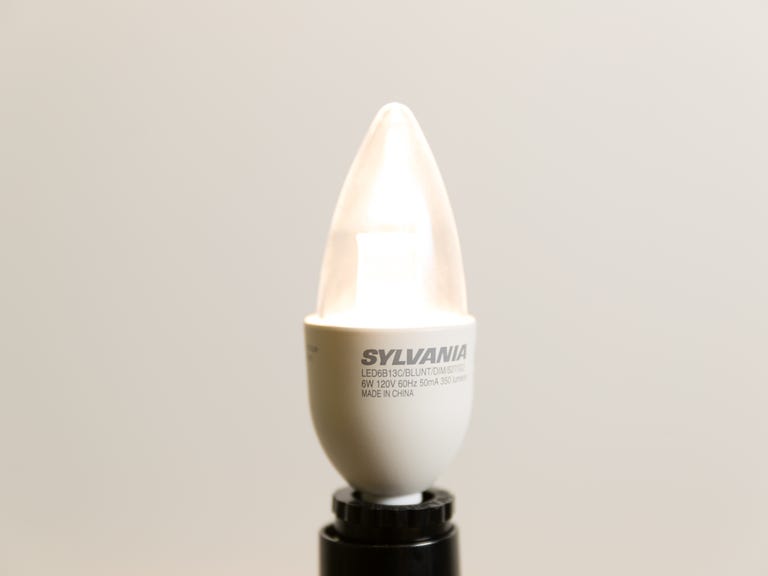 Why You Can Trust CNET
Why You Can Trust CNET Sylvania 40W Equivalent Candelabra LED review: Sylvania's candelabra LED is an ugly duckling that lights up like a swan
Sylvania's torpedo-shaped candelabra LED is one of the priciest we tested, but it did the trick in our tests.
The Sylvania 40W Equivalent Candelabra LED.
No, that isn't a conehead in a turtleneck, that's the Sylvania 40W Equivalent Candelabra LED. It's one of the uglier chandelier lights I've tested out, and at $11 each, one of the most expensive, too.
The Good
The Bad
The Bottom Line
But wouldn't you know it -- the thing's actually a pretty good little performer. With a light output of 466 lumens, it's one of the brightest bulbs we tested in this class, and it did a decent job in our dimming tests, too. And, thanks to that bulky heat sink around its base, it outperformed almost all of the bulbs we looked at in our thermal management tests. That means it'd be a solid pick for enclosed fixtures, where heat gets trapped.
Still, $11 per light is an awful lot, especially when you can get halogens and fluorescents for a fraction of that. I say stick it out with those for another year or so. After that, LEDs like these should (hopefully) be a better deal.
The 40W equivalent version of Sylvania's candelabra bulb puts out 466 lumens, making it the second brightest bulb we tested in this roundup. It gets some help, no doubt, from the 6-watt power draw -- none of the other LEDs we looked at use any more than 5 watts.
That brightness also gets an assist from the bulky heat sink wrapped around its base. It makes Sylvania's bulb the fattest of the bunch, and the heaviest, too, weighing about twice as much as the average candelabra LED. It also blocks off a fair amount of the bulb's downward light, compromising its omni-directionality. But it does its job with regards to heat, helping to draw it away from the delicate hardware inside of the bulb. As a result, that heat doesn't affect the brightness nearly as much as it does the competition.
Sylvania's LED (yellow) lost less of its brightness to heat than all but one of the other bulbs we tested.
All LEDs will lose a bit of their initial brightness in the first hour or so of use, as the heat starts to build up. Then, they'll flatten out at a "steady state" -- the point at which we take our final brightness measurements. In the graph above, that yellow line represents the Sylvania LED. It was one of only two bulbs we tested that hit a steady state higher than 90 percent. Nice work, little guy.
It also did well when we tested it out with our dimmer switches. I was able to get it down as low as 4 percent, which is a good result (the only better result would be if it dimmed cleanly down to zero -- only three of the bulbs we tested, the Cree, Walmart Great Value and Philips Warm Glow candelabra LEDs, could). I also didn't detect quite as much flicker as I did with some of the other bulbs I tested, though it's worth noting that none of them were flicker-free.
Compared with this GE Reveal incandescent (right), the Sylvania LED's light output is terribly uneven.
So, aside from the bulb's clunky design and uneven, borderline ugly light output, it really all comes down to value here. Let's look at the math. Say you have a chandelier with six 40W incandescent bulbs, and you want to replace them with Sylvania LEDs. You'll spend $66 on the bulbs, but then you'll save an average of about $24 a year in energy costs. That means that it'll take a little under three years to recoup the upfront costs.
Now consider standard, 60W replacement LEDs, some of which will recoup their upfront cost in as little as six months. That's a much, much better value. Candelabra LEDs simply aren't there yet -- especially not when they cost $11 each.
For that reason, I wouldn't blame you one bit if you wanted to stick with halogens, incandescents, or fluorescents for another year or two. There's still room for the price of these candelabra LEDs to come down, and for the performance and designs to improve.
For more on candelabra LEDs, check out our full category overview.


